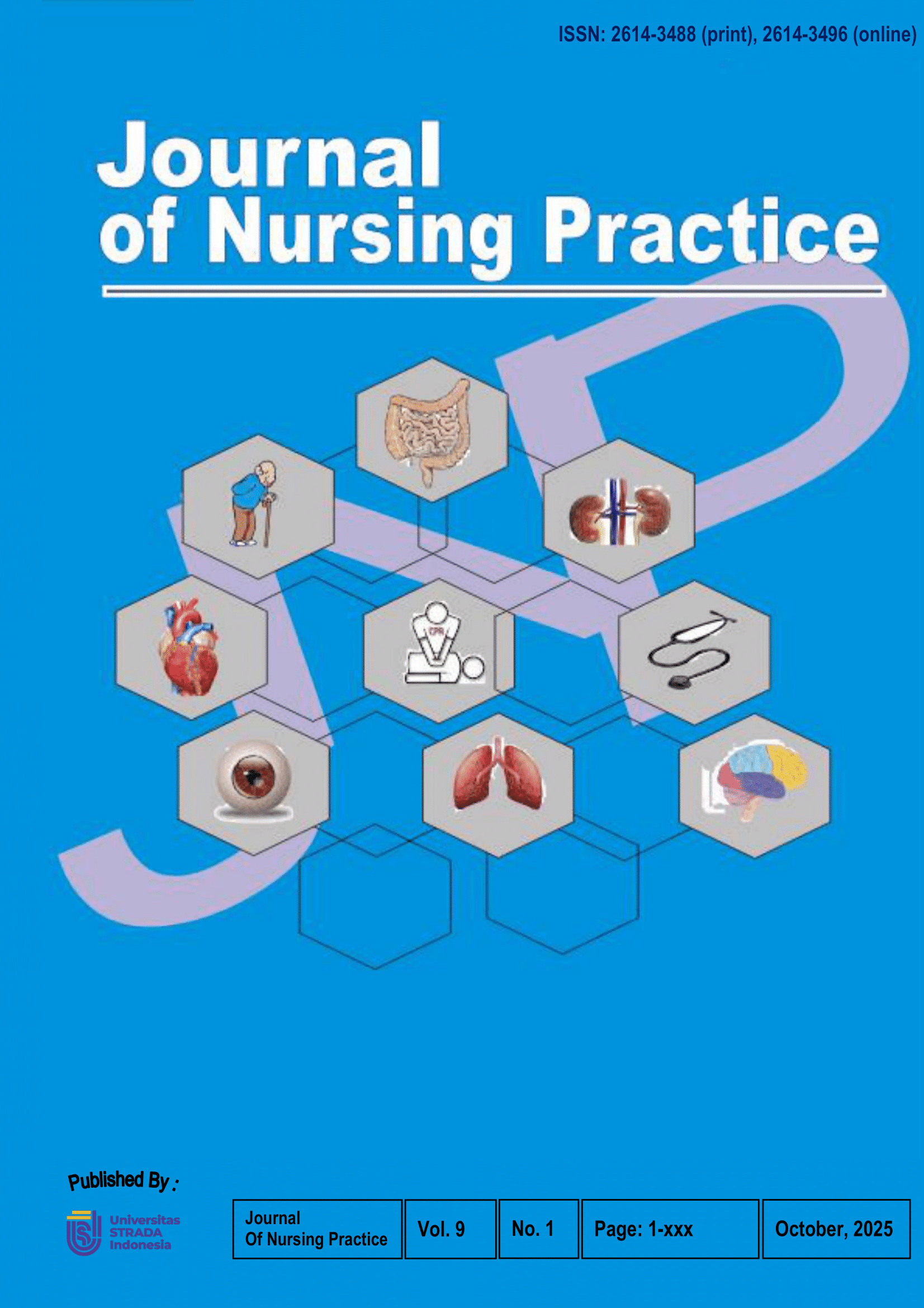The Effect of Pursed Lip Breathing and Diaphragmatic Breathing on Increasing Oxygen Saturation in COPD Patients
DOI:
https://doi.org/10.30994/jnp.v9i1.965Keywords:
COPD, diaphragmatic breathing, oxygen saturation, pursed lip breathingAbstract
Background: Chronic Obstructive Pulmonary Disease (COPD) is a progressive respiratory condition marked by continuous airflow limitation, often resulting in hypoxemia and hypercapnia. The WHO (1) projects that by 2030, COPD will rank as the third leading cause of death globally. In Indonesia, the prevalence of COPD reached 2.4% in 2018. One of the key clinical manifestations of COPD is a decline in oxygen saturation. Non-pharmacological breathing techniques such as Pursed Lip Breathing (PLB) and Diaphragmatic Breathing (DB) have been shown to improve ventilation and oxygenation.
Purpose: This study aimed to determine the effectiveness of PLB and DB in improving oxygen saturation among COPD patients.
Methods: A quasi-experimental one-group pre-post test design was used, involving 30 purposively selected COPD patients from a population of 35 treated. Each participant performed PLB and DB for 5-10 minutes per session, three times daily, for four weeks-initially during hospitalization and later at home under supervision. Inclusion criteria were COPD patients with oxygen saturation levels of 88–90% who had not previously received PLB or DB therapy. Exclusion criteria included those with prior experience of PLB/DB, anxiety, anti-anxiety treatment, as anxiety can alter breathing patterns and reduce therapy effectiveness. Data were collected using observation sheets and pulse oximeters and analyzed with Wilcoxon Signed Rank Test.
Results: Mean oxygen saturation increased from 89.40% (SD = 2.15) to 92.10% (SD = 1.98) with a significant p-value (0.000 < 0.05).
Conclusion: PLB and DB effectively enhance oxygen saturation in COPD patients and have important implications for evidence-based nursing practice and education.
Downloads
References
Amelia L, Oktobiannobel J, Hasbie NF, Ariza R, Soemarwoto S. Gambaran Kepatuhan Penggunaan Inhaler Kombinasi Laba/Lama Dan Quality Of Life Pada Pasien Ppok Kabupaten Pringsewu Provinsi Lampung. J Ilmu Kedokt dan Kesehat. 2023;10(5):1902–10.
Bhatt SP, Luqman-Arafath TK, Gupta AK, Mohan A, Stoltzfus JC, Dey T, et al. Volitional pursed lips breathing in patients with stable chronic obstructive pulmonary disease improves exercise capacity. Chron Respir Dis. 2013;10(1):5–10.
Kementerian Kesehatan RI. Penyakit Paru Obstruktif Kronis. 2022.
Kurniawan DB. Pengaruh Pursed Lip Breathing Terhadap Saturasi Oksigen Pada Pasien Post General Anesthesia Di Ruang Bedah Rs Lavalette Kota Malang. J Keperawatan Terap. 2022;8(1):11–8.
Poddighe D, Van Hollebeke M, Rodrigues A, Hermans G, Testelmans D, Kalkanis A, et al. Respiratory muscle dysfunction in acute and chronic respiratory failure: how to diagnose and how to treat? Eur Respir Rev. 2024;33(174).
Pratiwi PD, Perwitasari DA. Validation of St. George’s respiratory questionnaire (SGRQ) in chronic obstructive pulmonary disease (COPD) at Respira lung hospital Yogyakarta. J Manaj DAN PELAYANAN Farm (Journal Manag Pharm Pract. 2017;7(2):75–82.
Putra SH, Arafat R, Syam Y. Pengaruh Pursed Lips Breathing Terhadap Status Peningkatan Oksigenasi Perifer Dan Fungsi Ventilasi Paru Pada Pasien PPOK: A Literature Review. J Keperawatan Muhammadiyah. 2020.
Rismalah R, Rohimah S, Ginanjar Y. Literatur Review Pengaruh Teknik Pursed Lips Breathing (PLB) Terhadap Peningkatan Saturasi Oksigen pada Pasien Paru Obstruktif Kronik (PPOK). Juwara Galuh J Mhs Keperawatan Galuh. 2022;1:21–30.
Sakhaei S, Sadagheyani HE, Zinalpoor S, Markani AK, Motaarefi H. The impact of pursed-lips breathing maneuver on cardiac, respiratory, and oxygenation parameters in COPD patients. Open Access Maced J Med Sci. 2018;6(10):1851–6.
Sari. Angka Kecukupan Gizi Mayarakat Indonesia. Permenkes Nomor 28 Tahun 2019. 2019;Nomor 65(879):2004–6.
Sinambela AH, Tarigan AP, Pandia P. Pengaruh Latihan Fisik Terhadap Saturasi Oksigen pada Penderita Penyakit Paru Obstruktif Kronik Stabil. 2015.
Smeltzer SC, Bare BG. Brunner & Suddarth’s textbook of medical-surgical nursing. JB Lippincott Philadelphia; 1992.
Wahidati HW, Dwiningsih SU, Putrono P. The Effectiveness of Tripod Position and Pursed Lips Breathing to Enhance Oxygen Saturation in Patients With COPD. Jendela Nurs J. 2019;3(2):68–76.
WHO. WHO. 2024. No Title. Available from: https://www.who.int/en/news-room/fact-sheets/detail/chronic-obstructive-pulmonary-disease.
Yang Y, Wei L, Wang S, Ke L, Zhao H, Mao J, et al. The effects of pursed lip breathing combined with diaphragmatic breathing on pulmonary function and exercise capacity in patients with COPD: a systematic review and meta-analysis. Physiother Theory Pract. 2022;38(7):847–57.
Zepf S, El Haouij N, Lee J, Ghandeharioun A, Hernandez J, Picard RW. Studying personalized just-in-time auditory breathing guides and potential safety implications during simulated driving. In: Proceedings of the 28th ACM conference on user modeling, adaptation and personalization. 2020. p. 275–83.
Zulkifli Z, Mawadaah E, Benita BA, Sulastien H. Pengaruh Pursed Lip Breathing Exercise terhadap Saturasi Oksigen, Denyut Nadi dan Frekuensi Pernapasan pada Pasien Asma Bronkial. J Keperawatan Jiwa. 2022;10(1):203.
Downloads
Published
How to Cite
Issue
Section
License
Copyright (c) 2025 Journal Of Nursing Practice

This work is licensed under a Creative Commons Attribution-NonCommercial-ShareAlike 4.0 International License.

This work is licensed under a Creative Commons Attribution-NonCommercial-ShareAlike 4.0 International License.






















